Prairie Birds: The Stunning Species of the Grasslands
Updated: Jun. 22, 2023
Discover why prairie birds are the hidden gems of the grasslands, as well as some of the best birding locations to spot them.
When you think of the historic Great Plains, you probably imagine vast herds of bison grazing across the prairie. While this image is certainly accurate, those bison weren’t alone. Living alongside these substantial mammals were flocks of grassland or prairie birds.
About 40 species of North American birds are considered grassland specialists, but unfortunately, many populations have seen declines that mirror that of the bison. Still, while they might not be nearly as abundant as they once were, you can find these captivating birds if you know where to look.
You might think it would be easy to spot them in their wide-open landscapes, but think again. Sure, a meadowlark will sing loudly from a fencepost, but finding most grassland birds is like searching for a needle in a haystack—except you’re looking for the needle before the hay has been cut and stacked.
Don’t let that discourage you, though. Searching for prairie birds can be really rewarding—it forces you to slow down to a meander and to stop to take in your surroundings. Just take a look at some of the species you could see.
Western Meadowlark
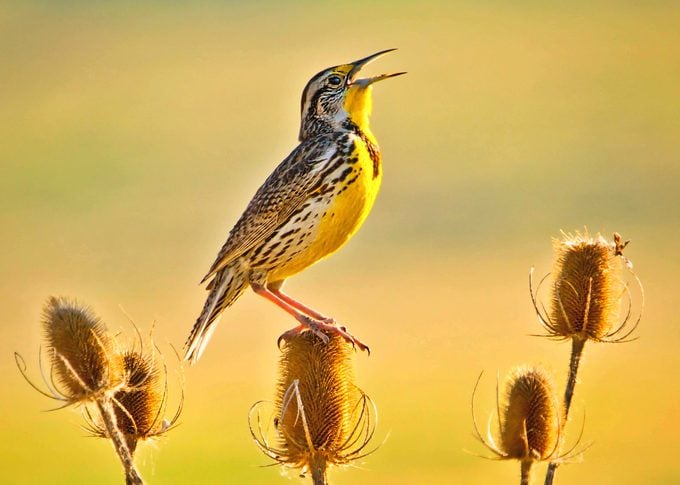
Despite the “lark” in the name, meadowlarks are related to blackbirds. Males sit on prominent perches and belt out bright whistling tunes. The bright yellow western meadowlark, state bird of six states, proclaims a pure melody followed by a short jumbled phrase.
Can you guess the official state bird of all 50 states?
Dickcissel
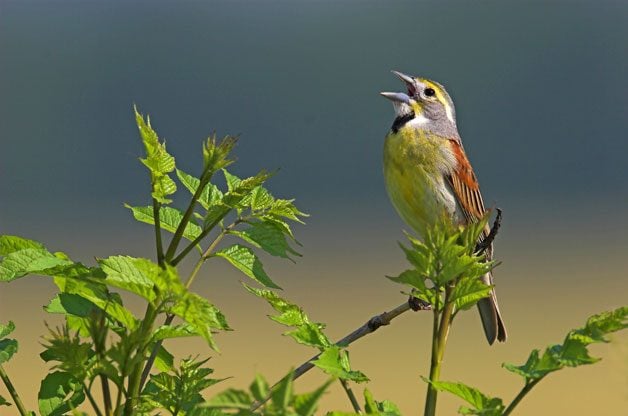
Resembling a smaller, skinnier meadowlark, the dickcissel has a core range in the heart of the Midwest. The first one I ever spotted was along an open prairie just off the interstate, eating seeds with its large beak.
During the winter, a few lingering dickcissels can be lured to backyard feeders. But the vast majority move as far south as northern South America for the season. Your best time to see one is summer.
Discover the desert birds of the southwest.
Bobolink
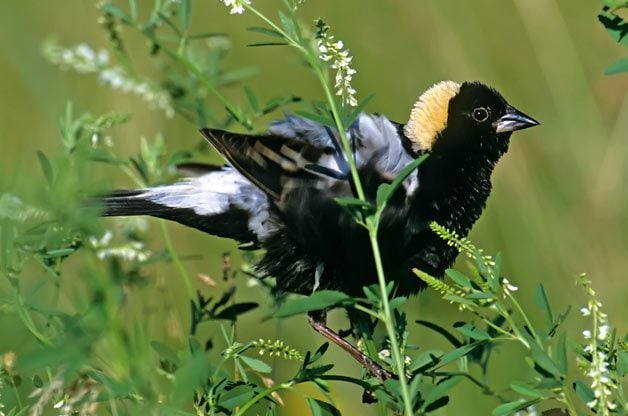
Black bodied, with a bold white wash along the back and a solid patch of straw yellow at the back of the head, male bobolinks are some of the grasslands’ most striking birds. They’ll often sing their unique song during in-flight displays to establish territories. Subtly colored females will mate with multiple males before laying eggs in nests built directly on the ground.
Never far from open meadows or marshes, bobolinks have expanded into the northeast as forests are converted to farms. Long-distance migrants to central South America, they’re especially fond of rice fields along their journey.
Learn about beach birds and coastal birding locations.
Grasshopper Sparrow
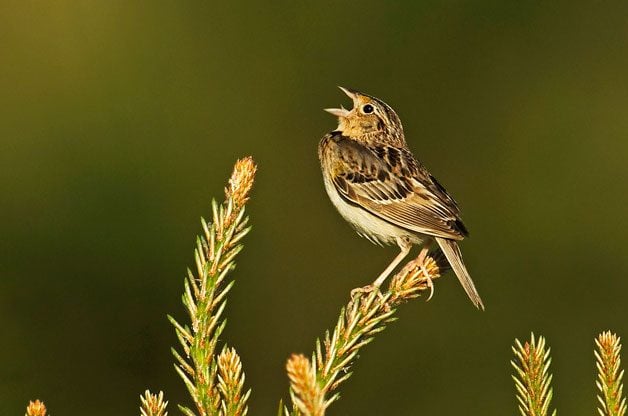
The sounds of the prairie always seem ephemeral to me. Just about the time I realize I’m hearing more than the breeze rustling the thick grass stems, the noise fades away like a dream. This is the case with the grasshopper sparrow and its high-pitched buzz, which resembles a grasshopper’s. You’ll want to learn to recognize this buzzing sound. Since these prairie birds like to stay low in the grass, hearing one might be your best chance to see one.
Learn all about sparrows: what birders should know.
Prairie-Chicken
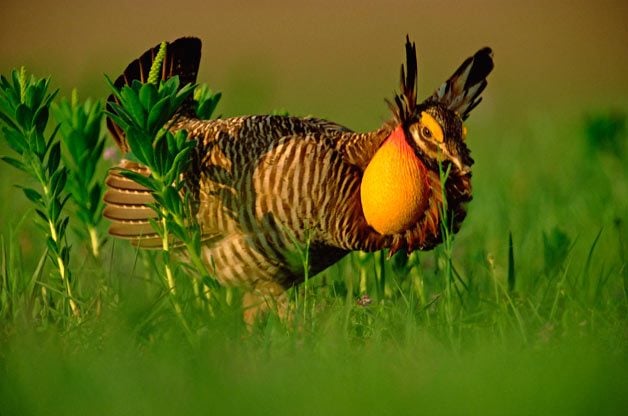
A sunrise visit to the grasslands can provide a unique opportunity to watch one of nature’s finest spectacles, the prairie-chicken strut. Throughout the spring, these birds gather at “leks,” as places where mating males congregate are called, to perform elaborate courtship displays. While inflating bright orange air sacs along the neck, males flip up specialized feathers like collars behind their heads.
They also make eerie cooing, hooting and booming sounds to woo females. A lek may be used year after year but can easily be disturbed, so many groups offer special guided trips for folks interested in viewing this yearly dance. Greater prairie-chickens are found in the upper Midwest, while lesser prairie-chickens live in the southern Great Plains.
Ferruginous Hawk
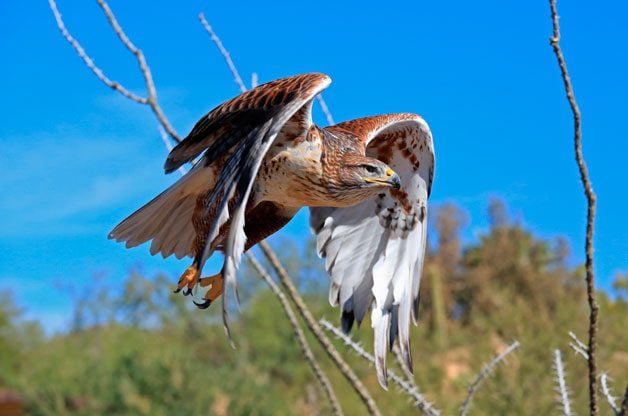
Similar to red-tailed hawks, ferruginous hawks are large raptors with broad wings built for soaring. There isn’t much to perch on in the prairie, so you’ll often see ferruginous hawks sitting directly on the ground. They’ll sometimes even build their nests on the ground, especially in rocky outcrops or along bluffs.
You can recognize ferruginous hawks in flight by the rusty brown V of the legs, contrasting with a mostly white underside. Year-round residents of the Four Corners region, where Colorado and Utah meet Arizona and New Mexico, the hawks breed as far north as the grasslands of southern Canada and winter as far south as central Mexico.
Learn how to identify Cooper’s hawks and sharp-shinned hawks.
Burrowing Owls
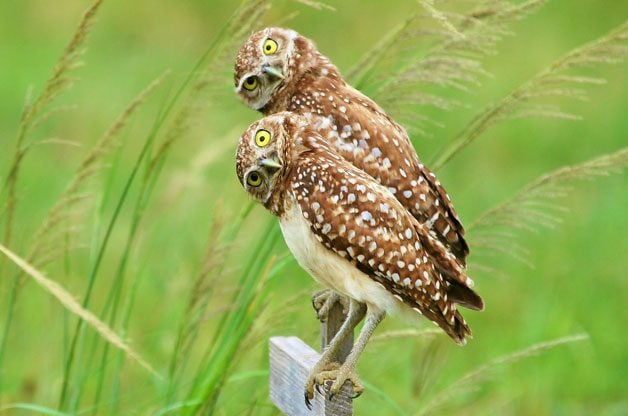
Most burrowing owls don’t actually burrow. Instead, they’ll take up residence in the tunnels of prairie dogs or other subterranean critters. Active by day and night, burrowing owls consume a diet rich in insects and small mammals. They’ll even bait insects by providing an animal-dung buffet.
Unlike most raptors, males and females are similar in dimension, with bodies roughly the size of a pint glass and long, skinny legs. Burrowing owls can be found in suitable habitats throughout the west, though an isolated group lives in Florida. (The Florida population actually does burrow.) They’re also found in the grasslands of South America.
Check out 15 outstanding pictures of owls.
These are some of my favorite grassland species, but I encourage you to set out on foot and find your own. There’s an amazing diversity just waiting to be discovered. And while the bison are gone from much of the plains, lots of grassland birds still make their home on the range.
4 Hotspots to See Grassland and Prairie Birds
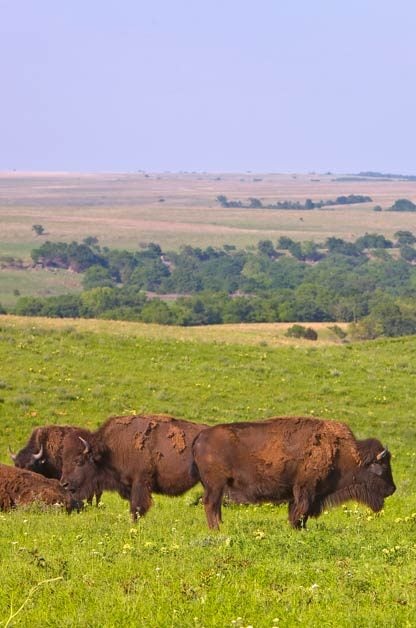
Native prairies and grasslands boast a remarkable biodiversity of plants, insects, birds and mammals. But grassland habitats have dwindled since the 19th century, so prairie bird species dependent on them have also declined. Much of the remaining grassland is privately owned. Grassland birds have benefited from conservation programs that encourage late-season mowing and grazing, as well as prairie restoration projects, including prescribed fires.
Oklahoma: Tallgrass Prairie Preserve
Nearly 2,500 bison roam the range on this large swath of northeastern Oklahoma prairie administered by the Nature Conservancy.
Kansas: Tallgrass Prairie National Preserve & Konza Prairie
The Flint Hills region of Kansas is a stunning grassland ecosystem where numerous groups collaborate on education, research and restoration efforts.
Ohio: The Wilds
Here grassland birds share the landscape not with bison but with grazers from around the world. Formerly a mining operation, the Wilds is a large-scale reclamation area with a dual focus on native ecosystems and global conservation efforts.
The Dakotas: Dakota Prairie National Grasslands
Dakota Prairie National Grasslands is a collection of agencies that oversees more than a million acres of diverse landscapes, from the tallgrass prairies of the Sheyenne National Grassland to the shortgrass badlands of the Little Missouri National Grassland.
Next, check out birding hotspots for spring sandhill crane migration.




















